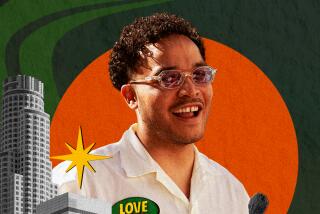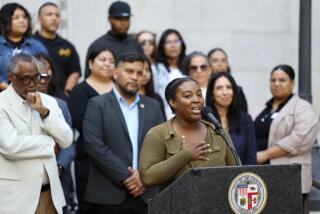IN THE NEIGHBORHOOD : South Central: Bootstrap Banking Fills a Void
- Share via
Only 19 bank and savings and loan branches serve 587,000 people who live in a 40-square-mile area of South-Central Los Angeles, according to a recent City Council study. In contrast, nearby Gardena had 21 branches serving 49,800 residents. Many argue that limited access to banks translates into tighter credit for minority borrowers. According to the San Francisco-based Greenlining Coalition, a multicultural financial industries watchdog group, of 24,702 home purchase loans made by California’s seven largest banks in 1991, only 11% went to African-American or Latino borrowers.
Where can people in the community turn? Nowadays, to the non-profit, member-owned South-Central People’s Federal Credit Union, which opened last month after five years of wrangling with federal regulators to get its charter. Those who live, work or worship in the community and their families become lifetime member-owners of the cooperative with a minimum deposit of $25 and a onetime fee of $10. In return, members receive retail banking services and may apply for home and business loans from an institution guided by a lending philosophy that considers a borrower’s character as much as their ability, on paper, to repay. Community development credit unions like this one gain extra capital for neighborhood loans because, unlike other credit unions, they can accept non-member deposits and use funds available through the federal National Credit Union Administration.
LOCAL POINT OF VIEW
(At a community credit union) the member is an owner, and it does make a difference. If you put $500 in a credit union it will be loaned to your neighbor or the guy down the street or somebody you don’t know, (but still) from your community. Banks come here and take a lot of deposits but they don’t loan it back to the community. In South Central, $18.5 million flowed out of this community in 1991 into check cashers’ hands. Do you have any idea what that money would do if it were here? My God, you could create so many jobs with that money, you could physically clean up the area, you could put a lot of kids here to work. I don’t want to knock top-down solutions, but if you look at some of (them)--and RLA is an example in my opinion--they never get to the street, and that’s where we are.
Diana Mullins, Consulting Manager, South Central People’s Credit Union
THE BIG PICTURE
Credit unions work when they’re innovative and creative. They can help break myths about what’s doable for other financial institutions. They can change what is considered a safe and sound loan. They can provide a leveraging influence for the broader financial community and provide direct inner-city impact.
Credit unions are an important part of the financial pie, but their asset base is too small for them to be seen as the solution (for economic development). The real solution for economic development is for banks, savings and loans, pension funds, investment houses and insurance companies to be involved in communities, too.
Robert Gnaizda, General Counsel for The Greenlining Coalition
WHAT DOES IT TAKE
COMMON BOND AND COMMUNITY SUPPORT
Credit unions rely on group loyalty generated by shared interests.
VOLUNTEERS
A core group of about 15 to 20 volunteers usually coordinates organizational efforts and serve on three essential credit union committees: the board of directors, the credit committee and the supervisory committee.
BUDGET AND PAID STAFF
Many credit unions that are open for one or two days a week run as all-volunteer operations, but a paid staff is usually hired for credit unions open more than that. South Central People’s Credit Union has two full-time employees.
CAPITAL
There are no capital requirements to obtain a credit union charter. Instead, organizers must document deposit commitments from individuals and organizations pledged to the credit union once it opens its doors. Successful groups usually gather $100,000 to $750,000 in pledges, depending on credit union’s proposed membership size. South Central People’s Credit Union gathered more than $5 million in pledges.
TIME
The chartering process takes an average 12 to 18 months, although the case of the South Central People’s Federal Credit Union proves it can take much longer.
SERVICE PLAN
Depending on asset base and management experience, credit unions may offer transaction services like checking, money orders and wire transfers; savings accounts; loans for housing and for businesses; and credit cards.
TO GET INVOLVED
For membership information about the South Central People’s Federal Credit Union or about their grand opening celebration on October 21, call (213) 299-9560.
For information about community development credit unions, contact the National Federation of Community Development Credit Unions, 120 Wall St., 10th floor, New York, NY 10005-3902, (212) 809-1850.
More to Read
Sign up for Essential California
The most important California stories and recommendations in your inbox every morning.
You may occasionally receive promotional content from the Los Angeles Times.










